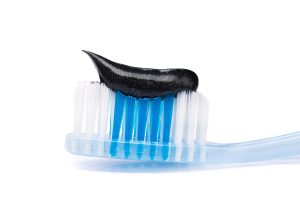
You see people all over your socials brushing with activated charcoal as an attention-grabbing way to “naturally” whiten your smile. But while charcoal toothpaste might be trendy and look edgy, just because something is popular doesn’t mean it’s good for you, or your teeth.
So, is this natural remedy actually helping your smile, or could it be causing more harm than good?
What is Charcoal Toothpaste?
Activated charcoal is a fine black powder made from things like coconut shells, wood, or bamboo. It’s processed at very high temperatures, which claims to detoxify. It’s shown up in face masks, detox drinks, and, you guessed it, toothpaste.
The idea is that it can “absorb” stains and leave your teeth sparkling white. The theory sounds great. An all-natural way to improve your appearance? But natural does not always equal safe.
Is it Really Effective?
If everyone swears by it, it must work, right? The truth is that, charcoal toothpaste might give your teeth a cleaner look after brushing, but that doesn’t necessarily mean it’s actually whitening them deep down. In most cases, the difference you’re seeing is from surface-level polishing.
Unlike professional tooth whitening treatments and even many whitening toothpastes that contain hydrogen peroxide or other proven bleaching agents, most charcoal toothpastes rely purely on abrasiveness to scrub off stains.
The Problem with Abrasive Whiteners
Your enamel is tough, but it’s not invincible. Once it wears down, it doesn’t grow back. And because charcoal particles can be rough and gritty, brushing with charcoal toothpaste on a regular basis can slowly erode that protective layer.
Over time, enamel erosion can make your teeth look more yellow (not less) because the underlying dentin starts to show through. In addition, worn enamel can make teeth more sensitive and even more prone to decay.
Lastly, many charcoal toothpastes don’t contain fluoride, which means you’re missing out on cavity protection every time you brush. Without fluoride, you’re not helping to remineralize your enamel or strengthen it against everyday acid attacks from food and drink.
What to Use Instead of Charcoal Toothpaste
If you’re already using charcoal toothpaste, don’t panic! Using it occasionally isn’t likely to do serious damage. But it shouldn’t replace your standard fluoride toothpaste.
Not to worry! If your smile is dull or stained and you want whiter teeth without the risks, there are safer and more effective options out there. How do they stack up?
Whitening Toothpastes (with Bleaching Agents)
We suggest being wary of any whitening toothpaste, as even non-charcoal options can contain powerful abrasives that have the potential to wear away tooth enamel. If you want to try a particular brand, clear it with your dentist first.
Over The Counter Kits
Most over-the-counter kits are safe enough for occasional use. They typically work by applying mild bleaching agents to the surface of teeth for a short time. Results can be noticeable, but are typically not as dramatic as professional options. Always use these products as directed, and never leave them on teeth longer than suggested by the manufacturer.
Professional Tooth Whitening
For more dramatic results you know are safe, professional whitening treatments from your dentist are always your best bet. In addition to using stronger, more effective whitening agents tied to more modern, personalized technology, they come with expert oversight so you know it’s safe for your teeth and gums.
Even better? Both at-home and in-office professional tooth whitening treatments are available.
Want Whiter Teeth Now?
If you are looking to brighten your smile, there are safer, smarter ways that won’t compromise the long-term health of your teeth.
Schedule a consultation today and let us recommend the best options for safe, effective whitening that protects your enamel and boosts your confidence.